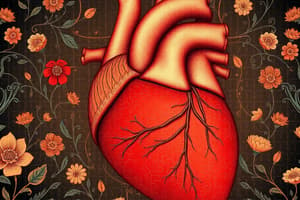Podcast
Questions and Answers
Which of the following variables does NOT influence stroke volume?
Which of the following variables does NOT influence stroke volume?
- Heart rate (correct)
- Inotropic agents
- Venous return
- Afterload
What is the typical end-diastolic volume (EDV) in a resting adult?
What is the typical end-diastolic volume (EDV) in a resting adult?
- 130 mL (correct)
- 60 mL
- 150 mL
- 100 mL
What is the typical end-systolic volume (ESV) in a resting adult?
What is the typical end-systolic volume (ESV) in a resting adult?
- 50 mL
- 70 mL
- 60 mL (correct)
- 40 mL
What is the formula for calculating stroke volume (SV)?
What is the formula for calculating stroke volume (SV)?
Which of the following factors influences end-diastolic volume (EDV)?
Which of the following factors influences end-diastolic volume (EDV)?
Which of the following factors influences end-systolic volume (ESV)?
Which of the following factors influences end-systolic volume (ESV)?
What is the primary mechanism by which sympathetic stimulation increases heart rate?
What is the primary mechanism by which sympathetic stimulation increases heart rate?
What is the role of thyroid hormone (TH) in increasing heart rate?
What is the role of thyroid hormone (TH) in increasing heart rate?
How do certain chemical compounds, such as nicotine, cocaine, and caffeine, increase heart rate?
How do certain chemical compounds, such as nicotine, cocaine, and caffeine, increase heart rate?
What is the role of Ca2+ influx in the SA nodal cells during sympathetic stimulation?
What is the role of Ca2+ influx in the SA nodal cells during sympathetic stimulation?
How do drugs that act on this pathway increase heart rate?
How do drugs that act on this pathway increase heart rate?
What is the role of the AV node in the increase in heart rate during sympathetic stimulation?
What is the role of the AV node in the increase in heart rate during sympathetic stimulation?
Which of the following best describes the term 'systole'?
Which of the following best describes the term 'systole'?
What initiates the contraction of the ventricular muscles?
What initiates the contraction of the ventricular muscles?
What is the primary driving force that ensures the unidirectional movement of blood through the heart and the opening and closing of heart valves?
What is the primary driving force that ensures the unidirectional movement of blood through the heart and the opening and closing of heart valves?
During the initial phase of ventricular contraction, what happens to the atrioventricular (AV) valves?
During the initial phase of ventricular contraction, what happens to the atrioventricular (AV) valves?
Which of the following statements accurately describes the relationship between pressure changes and the movement of blood in the heart?
Which of the following statements accurately describes the relationship between pressure changes and the movement of blood in the heart?
What is the purpose of the tendinous cords and papillary muscles in relation to the AV valves?
What is the purpose of the tendinous cords and papillary muscles in relation to the AV valves?
During the initial phase of ventricular contraction, what is the state of the semilunar valves?
During the initial phase of ventricular contraction, what is the state of the semilunar valves?
Which of the following statements accurately describes the action of heart valves during ventricular contraction?
Which of the following statements accurately describes the action of heart valves during ventricular contraction?
During the initial phase of ventricular contraction, what happens to the blood volume within the ventricular chambers?
During the initial phase of ventricular contraction, what happens to the blood volume within the ventricular chambers?
Which of the following statements accurately describes the relationship between the opening and closing of heart valves?
Which of the following statements accurately describes the relationship between the opening and closing of heart valves?
What event marks the beginning of the ventricular ejection phase?
What event marks the beginning of the ventricular ejection phase?
Which of the following analogies best describes the action of heart valves during the cardiac cycle?
Which of the following analogies best describes the action of heart valves during the cardiac cycle?
Which of the following statements about venous return is accurate?
Which of the following statements about venous return is accurate?
What is the primary factor that determines balanced ventricular output?
What is the primary factor that determines balanced ventricular output?
What happens when you start to exercise and venous return from the body into the right side of the heart increases?
What happens when you start to exercise and venous return from the body into the right side of the heart increases?
What is the relationship between stroke volume and inotropic agents?
What is the relationship between stroke volume and inotropic agents?
What is the effect of a low resting heart rate on venous return?
What is the effect of a low resting heart rate on venous return?
What is the consequence of low blood volume or an abnormally high heart rate?
What is the consequence of low blood volume or an abnormally high heart rate?
Flashcards are hidden until you start studying




